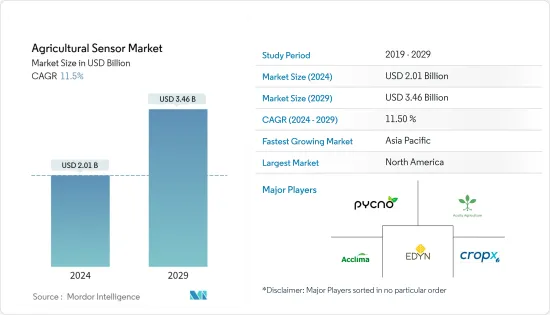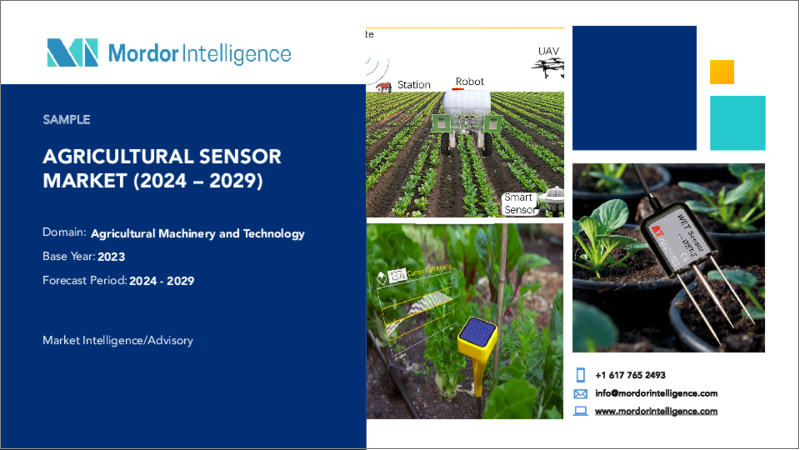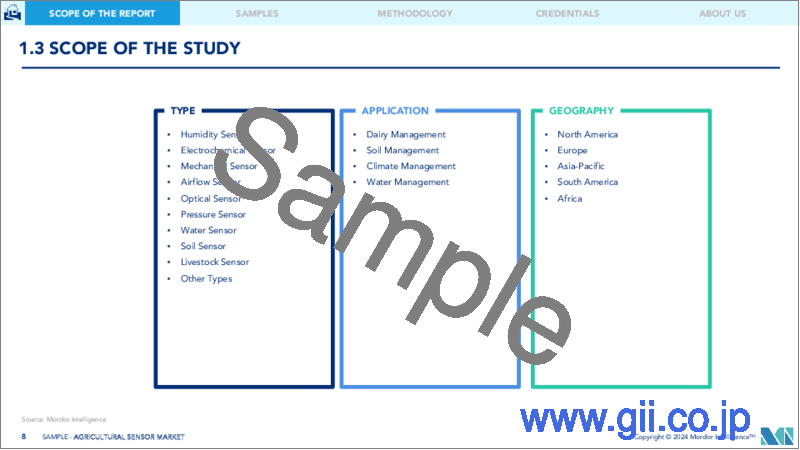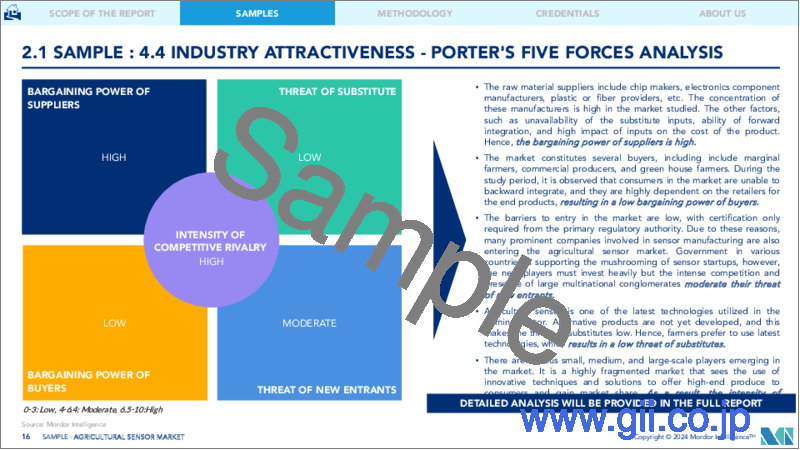|
|
市場調査レポート
商品コード
1437885
農業用センサー:市場シェア分析、業界動向と統計、成長予測(2024~2029年)Agricultural Sensor - Market Share Analysis, Industry Trends & Statistics, Growth Forecasts (2024 - 2029) |
||||||
カスタマイズ可能
適宜更新あり
|
|||||||
| 農業用センサー:市場シェア分析、業界動向と統計、成長予測(2024~2029年) |
|
出版日: 2024年02月15日
発行: Mordor Intelligence
ページ情報: 英文 120 Pages
納期: 2~3営業日
|
全表示
- 概要
- 目次
農業用センサーの市場規模は、2024年に20億1,000万米ドルと推定され、2029年までに34億6,000万米ドルに達すると予測されており、予測期間(2024年から2029年)中に11.5%のCAGRで成長します。

主なハイライト
- 農業生産の需要の増加、技術慣行の変化、精密農業、低耕作管理、先端技術などの集約化は、農業用センサー市場を推進するいくつかの要因です。
- 農業用センサーは、この地域で完全に拡大することが期待されています。位置センサーは、精密農業における正確な位置決めの必要性から、近年非常に注目を集めています。中国では、「空・大地・宇宙」をモットーに、2018年に黒竜江省現代農業実証区に大規模農業デジタルゾーンが設立されました。「空」は衛星リモートセンシングデータ、「空間」はドローンリモートセンシングデータを意味するセンシングデータ、「Ground」は地上IoTデータです。
- 多くのアグリテック企業は、収量監視、作物の健全性監視、圃場マッピング、灌漑スケジュール、収穫管理などに関するリアルタイムの意思決定を可能にする無線プラットフォームに重点を置くことで、農作業を容易にする革新的なモデルを開発し、農家を不利な状況から支援しています。彼らの農産物の価格変動。
- 北米は依然として市場の最大の地理的セグメントであり、主要な市場シェアを占めています。多額の投資とスマート農業技術の広範な採用により、予測期間中にセンサー農業が大幅に成長する可能性が示されています。厳しい環境規制と、大小の農場所有者による精密農業の採用の増加と、畑の生産性を向上させるための収量監視手法が市場を牽引すると予想されます。
農業用センサーの市場動向
労働要件の減少
精密な屋内農業技術には、変動する気候条件と熟練労働力の減少課題に対処するための新しい技術が必要です。農家は屋内だけで作物を栽培する場合、光量、栄養レベル、水分レベルを制御できます。堅牢な機能を備えた小規模制御システムを備えたセンサーにより、企業はシステムを自動化し、より良い方法で歩留まりを向上させることができます。センサーの導入後は、労働力が約20.0%削減される可能性があります。農業用センサーは、屋内農場における労働力の課題に対処できます。
大規模な工業用屋内農場では、水質汚染、残留農薬、栄養素不足、病気の攻撃などを感知できるセンサーが使用されています。屋内農業と農業用センサーの組み合わせにより、作物の生産能力が向上し、将来的には農業用センサー市場を牽引する可能性があります。
そのため、土壌水分センサーなどのハイテク灌漑ツールは、農家が各地域で必要な水のレベルを決定するのに役立ちます。 IoT対応デバイスのスマート灌漑アプリケーションは、灌漑設備の制御と監視を支援し、変化する要件に基づいて調整することができます。どちらも、地下水位が低下した地域で精密灌漑を実施できる幅広い範囲を表しています。これらの要因は、予測期間中に市場を牽引する可能性があります。
北米が市場を独占
北米は農業用センサーの最大の地域市場です。農業生産を増加させるための政府の強力な支援、インフラ支援の利用可能性、スマートおよび歳差農業法の受け入れにより、先進的な農業ソリューションの導入が増加しました。北米では、土壌水分センサーの採用が急速に増加しています。土壌水分計は、芝草のより効率的な監視と変換のためにスポーツ芝生分野で使用されています。研究によると、センサーを導入することで農家は干ばつストレスを最小限に抑え、保護栽培の維持費と人件費を少なくとも20%削減できることがわかっています。
米国は精密農業技術をいち早く導入しており、これがこの地域の世界市場における最大のシェアの主な要因となっています。米国の農業セクターは近年、スマート農業実践の導入に関して画期的な革命を経験しています。モノのインターネット(IoT)携帯電話デバイス、歯車センサーベースの灌漑および施肥装置、バルブ位置センサーなどのセンサーベースの技術の出現はこの分野では比較的新しいもの、この国では新たな現象が見られています。主に農民が採用する機械化率の増加とスマート農業慣行により、センサーの需要が見つかりました。カナダによる現代農業手法の大幅な受け入れは、産業の成長に貢献しています。
農業用センサー業界の概要
農業用センサー市場は細分化されており、さまざまな中小企業と少数の大手企業が市場で活動しており、その結果、激しい競合が発生しています。市場の主要企業には、Edyan、Acclima Inc.、CropX inc.、Pycno、Acquity Agricultureなどがあります。世界各地での地域市場と地元企業の発展が、市場の細分化の主な要因です。北米とアジア太平洋地域は、競合他社の活動が最も活発である2つの地域です。
その他の特典
- エクセル形式の市場予測(ME)シート
- 3か月のアナリストサポート
目次
第1章 イントロダクション
- 調査の前提条件と市場の定義
- 調査範囲
第2章 調査手法
第3章 エグゼクティブサマリー
第4章 市場力学
- 市場概要
- 市場促進要因
- 市場抑制要因
- 業界の魅力- ポーターのファイブフォース分析
- 買い手の交渉力
- 供給企業の交渉力
- 代替製品の脅威
- 新規参入業者の脅威
- 競争企業間の敵対関係の激しさ
第5章 市場セグメンテーション
- タイプ
- 湿度センサー
- 電気化学センサー
- 機械式センサー
- エアフローセンサー
- 光学センサー
- 圧力センサー
- 水センサー
- 土壌センサー
- 家畜センサー
- その他のタイプ
- 用途
- 酪農管理
- 土壌管理
- 気候管理
- 水管理
- 地域
- 北米
- 米国
- カナダ
- メキシコ
- 北米のその他の地域
- 欧州
- ドイツ
- 英国
- フランス
- スペイン
- イタリア
- その他欧州
- アジア太平洋
- 中国
- インド
- タイ
- 日本
- オーストラリア
- その他アジア太平洋地域
- 南米
- ブラジル
- アルゼンチン
- その他南米
- アフリカ
- 南アフリカ
- アフリカの残りの部分
- 北米
第6章 競合情勢
- 最も採用されている戦略
- 市場シェア分析
- 企業プロファイル
- Libelium Comunicaciones Distribuidas Sl
- Auroras
- Acquity Agriculture
- Pycno
- Agsmarts Inc.
- Edyn
- Acclima Inc.
- Caipos GmbH
- Vegetronix Inc.
- Sentek Ltd
- Aquaspy Inc.
- CropX
第7章 市場機会と将来の動向
The Agricultural Sensor Market size is estimated at USD 2.01 billion in 2024, and is expected to reach USD 3.46 billion by 2029, growing at a CAGR of 11.5% during the forecast period (2024-2029).

Key Highlights
- Increasing demand for agricultural production, changing technology practices, and increasing intensification, including precision agriculture, low-till management, and advanced technology, are a few factors driving the agricultural sensors market.
- Agricultural sensors are expected to achieve complete expansion in the region. Location sensors have gained immense traction in recent years for the need for precise positioning in precision agriculture. In China, a large-scale agriculture digital zone was established in the Heilongjiang Modern Agriculture Demonstration Zone in 2018 under the motto 'Sky, Earth, and Space,' where "Sky" stood for satellite remote sensing data, "Space" for drone remote sensing data, and "Ground" for ground IoT data.
- Many agritech companies developed innovative models for easing farming practices by focusing more on wireless platforms to enable real-time decision-making regarding yield monitoring, crop health monitoring, field mapping, irrigation scheduling, harvesting management, etc., for helping the farmers from adverse price fluctuations of their produce.
- North America remains the largest geographical segment of the market and accounts for a major market share. High investments and wide adoption of smart farming techniques show huge potential growth for sensor farming during the forecast period. Stringent environmental regulations and the rising adoption of precision farming and yield monitoring practices by large and small farm owners to upsurge the productivity of fields are expected to drive the market.
Agricultural Sensor Market Trends
Decreased Number of Labor Requirements
Precision and indoor farming techniques demand new techniques to address the challenges of fluctuating climatic conditions and decreased skilled labor force. The farmer can control light amounts, nutrition levels, and moisture levels when they are growing crops solely indoors. Sensors with small-scale control systems with robust functionality would allow businesses to automate their systems and increase yields in a better way. The post-adoption of sensors may reduce the labor force by around 20.0%. Agricultural sensors can address the labor challenge in indoor farms.
Big industrial indoor farms use sensors that can sense water contamination, pesticide residues, nutrient shortages, disease attacks, etc. The combination of indoor farming and agricultural sensors will likely enhance crops' production capacities, which may drive the agricultural sensors market in the future.
As such, high-technology irrigation tools, such as soil moisture sensors, can help farmers determine the level of water requirement in each area. Smart irrigation applications in IoT-enabled devices can help control and monitor the irrigation equipment to adjust it based on changing requirements. Both represent a wide scope for undertaking precision irrigation in regions with depleted groundwater levels. These factors are likely to drive the market during the forecast period.
North America Dominates the Market
North America is the largest regional market for agricultural sensors. Strong government support to increase agricultural production, availability of infrastructure support, and acceptance of smart and precession farming methods increased the deployment of advanced farming solutions. In North America, the adoption of soil moisture sensors has rapidly increased. Soil moisture instruments are used in the sports turf segment for more efficient monitoring and conversion of turfgrass. Studies indicate that adopting sensors helps farmers minimize drought stress and reduces maintenance and labor costs of protected cultivation by at least 20%.
The United States is the early adopter of precision farming technologies, the primary factor responsible for the region's most significant share in the global market. The US agricultural sector has undergone a groundbreaking revolution regarding adopting smart farming practices in recent years. Although the advent of sensor-based technologies, such as Internet of Things (IoT) cellular devices, gear tooth sensor-based irrigation and fertilization equipment, and valve position sensors, is relatively new in the domain, the country has been witnessing a new-found demand for sensors, primarily due to the increased rate of mechanization and smart agricultural practices adopted by the farmers. A considerable acceptance of modern agriculture methods by Canada is contributing to industry growth.
Agricultural Sensor Industry Overview
The agricultural sensor market is fragmented, with various small and medium-sized companies and a few big players operating in the market, resulting in stiff competition. Some of the major players in the market include Edyan, Acclima Inc., CropX inc., Pycno, and Acquity Agriculture. The development of regional markets and local players in different parts of the world is the major factor for the fragmented nature of the market. North America and Asia-Pacific are the two regions showing maximum competitor activities.
Additional Benefits:
- The market estimate (ME) sheet in Excel format
- 3 months of analyst support
TABLE OF CONTENTS
1 INTRODUCTION
- 1.1 Study Assumptions and Market Definition
- 1.2 Scope of the Study
2 RESEARCH METHODOLOGY
3 EXECUTIVE SUMMARY
4 MARKET DYNAMICS
- 4.1 Market Overview
- 4.2 Market Drivers
- 4.3 Market Restraints
- 4.4 Industry Attractiveness - Porter's Five Forces Analysis
- 4.4.1 Bargaining Power of Buyers
- 4.4.2 Bargaining Power of Suppliers
- 4.4.3 Threat of Substitute Products
- 4.4.4 Threat of New Entrants
- 4.4.5 Intensity of Competitive Rivalry
5 MARKET SEGMENTATION
- 5.1 Type
- 5.1.1 Humidity Sensor
- 5.1.2 Electrochemical Sensor
- 5.1.3 Mechanical Sensor
- 5.1.4 Airflow Sensor
- 5.1.5 Optical Sensor
- 5.1.6 Pressure Sensor
- 5.1.7 Water Sensor
- 5.1.8 Soil Sensor
- 5.1.9 Livestock Sensor
- 5.1.10 Other Types
- 5.2 Application
- 5.2.1 Dairy Management
- 5.2.2 Soil Management
- 5.2.3 Climate Management
- 5.2.4 Water Management
- 5.3 Geography
- 5.3.1 North America
- 5.3.1.1 United States
- 5.3.1.2 Canada
- 5.3.1.3 Mexico
- 5.3.1.4 Rest of North America
- 5.3.2 Europe
- 5.3.2.1 Germany
- 5.3.2.2 United Kingdom
- 5.3.2.3 France
- 5.3.2.4 Spain
- 5.3.2.5 Italy
- 5.3.2.6 Rest of Europe
- 5.3.3 Asia-Pacific
- 5.3.3.1 China
- 5.3.3.2 India
- 5.3.3.3 Thailand
- 5.3.3.4 Japan
- 5.3.3.5 Australia
- 5.3.3.6 Rest of Asia-Pacific
- 5.3.4 South America
- 5.3.4.1 Brazil
- 5.3.4.2 Argentina
- 5.3.4.3 Rest of South America
- 5.3.5 Africa
- 5.3.5.1 South Africa
- 5.3.5.2 Rest of Africa
- 5.3.1 North America
6 COMPETITIVE LANDSCAPE
- 6.1 Most Adopted Strategies
- 6.2 Market Share Analysis
- 6.3 Company Profiles
- 6.3.1 Libelium Comunicaciones Distribuidas Sl
- 6.3.2 Auroras
- 6.3.3 Acquity Agriculture
- 6.3.4 Pycno
- 6.3.5 Agsmarts Inc.
- 6.3.6 Edyn
- 6.3.7 Acclima Inc.
- 6.3.8 Caipos GmbH
- 6.3.9 Vegetronix Inc.
- 6.3.10 Sentek Ltd
- 6.3.11 Aquaspy Inc.
- 6.3.12 CropX





